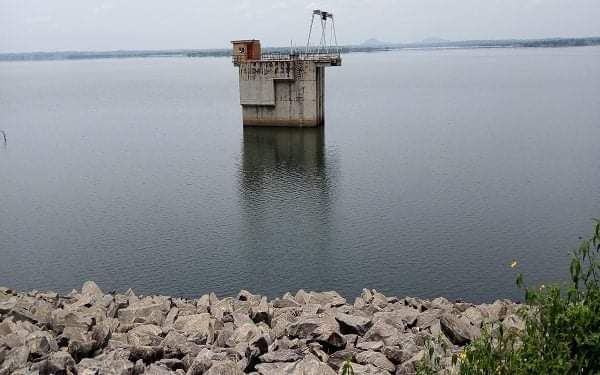
Ikere Dam in Ekiti State offers Nigeria the opportunity for cleaner power and massive fish production, but as GABRIEL OGUNJOBI finds out, not much is being done to tap into it.
Ichochepo Isa, a native Idoma, from Plateau State, Middle Belt Nigeria, decided to cast his net upon the waters one late September morning at Ikere Gorge Dam in Iseyin, northern Oyo state in Nigeria’s west.
It was the second time his attempt would be close to futility but he hoped to return again that evening after observing siesta. As at 2 pm, he had caught a total of eleven pieces of tilapia fish and the only reason he alluded for the “poor” harvest was that there was ‘no fish in the river.’
How a reservoir of about 565 million cubic metre gross capacity – the biggest in Southwestern region of the country – could run out of fishes presents a case of barren splendour. How this happened was rather rather puzzling until Mr Isa started narrating his plight, which affects others, more explicitly.
Ikere Gorge Dam is one of the two large dams constructed by the Ogun-Osun River Basin Development Authorities, as part of the master plan for the comprehensive development of the potential water resources of the basins of the Ogun River.
Despite its splendor, investigation confirmed that the reservoir remains bedeviled with neglect, and the entire project exists in ruins.
Nigeria is said to produce around 1 million tonnes of fish per year: 313,231 metric tons from aquaculture and 759,828 metric tons from fisheries. Added to that, over 600,000 tonnes of fish—primarily marine fish—are imported per year to meet the demand of Nigeria’s growing population.
In September 2019, Governor of the Central Bank of Nigeria, Godwin Emefiele, noted that about $1.2bn worth of fish is imported into the country annually. Besides, the demand for fish was 2.7 million tons, giving a deficit of 1.9 million tons.
According to the Food and Agriculture Organisation, Nigeria is the fourth importer of fish globally as at today.
Aquaculture in general, however, can help meet the demand for fish domestically and Ikere Gorge Dam’s quota to this would have helped in beating the supply-demand gap.
From Plateau to Little: Fishermen are paying more to earn a meagre
Ordinarily, the water resources in Ikere Township is sufficient to make fishermen and women economically productive and buoyant.
The unending challenges, however, are about climate change and their infrastructural deficit, making the fishing business unlucrative.
Plateau-born Ochochepo Isa travelled from far away North to Iseyin with family only to live from hand to mouth in fishing
It was the fishing potential that attracted Ochochepo to migrate from Plateau with his six-member family in 2017.
His kinsmen who had stayed in the community for quite some time convinced him to relocate but left out the part of the story that fishing may be hard whenever the rainfall ceased. 2020 is the year that nightmare haunted the most.
‘We have not really experienced constant rainfall this year. That is why the fish are not much but whenever it begins to rain, the harvest increases.’
Experts agree that the call for climate action has never been more crucial globally than now. Various researches established that human activities such as bush burning and deforestation constitute the depletion of the ozone layer.
Regarding fishing, ‘what is common in our rural communities is the use of firewood for cooking which is not a clean energy’, says Mrs. Alison Adedayo, the Principal Consultant of the African Energy Advocacy Initiative.
Isa’s wife roasting fishes using firewood the actual concern of experts about climate change
‘Felling of trees is an act of deforestation. It will depopulate the number of trees in the environment which could absorb carbon dioxide within the atmosphere.’
To put it mildly, drying up of the rivers through evaporation is inevitable when this happens, it was added.
Water shedding of the reservoir is another action that determines the extent of fishing harvest.
The action, according to Ikere fishermen, is that: ‘when they open the dam, the movement pattern of the fish changes and becomes very difficult to catch.’
Most of the men and women exploring the Ikere Gorge dam for fishing harvest estimated that an average of 10 to 20 pieces per day for an extended dry season in a year.
Depending on the size of a piece of fish, the price ranges between N100 and N200. Essentially, a lucky fisherman/woman is able to make roughly N2000 on any market day.
With the aid of good fishing materials, these fishermen and women can explore the dam efficiently round the year.
‘There are some materials that can work throughout all seasons but we don’t have them here. With good materials, fishing will be fun’, Ochochepo added.
But Simeon Johnson takes any idea about government’s intervention with a pinch of salt. As claimed, his grouse was largely over fishing permit charge that has served him nothing in return.
It was confirmed that up to three years ago, the fishermen paid N2,500 to the OORBDA. Many of them also claimed it doubled to N5,000 from 2018 till date.
A source said there are at least 100 fishermen in Ikere Gorge Dam. Given that, an average of five hundred thousand naira is remitted to the OORBDA from at least 100 fishermen and women annually.
‘We are the ones that eat our fish ourselves. The roads are not good to transport fish to the city,’ he said.
The 30-kilometre road is evidently deplorable. Several pot-holes on the route to the farmland area reel the tyres and turn a trip from Iseyin market to Ikere that should take 45 minutes now to 1 hour 30 minutes.
It was a sad instance on September 22 when a motorcycle rider conveying a couple of Togo descent to farm, ran into a truck. Out of the three on the motorcycle, only the couple’s young child was spared from the accident.
An eyewitness, who volunteered as caregiver to the deceased parents’ daughter until the family came to claim her, confirmed the incident.
By and large, the challenges faced by Iseyin fishermen minimised a source of wealth to a meagre.
Much water, more darkness: the failed hydropower project
Lack of mechanised implements as well as climate change are not the only factors taking a toll on the local fishermen in Ikere. The people have also lived in perpetual darkness for ages.
Ali Yusuf, a fisherman and also a father of ten, has a better story to tell after living in the community for 25 years.
‘If we have an uninterrupted power supply, we’ll enjoy life more than those in the cities’, he says, strong-willed about dreamt good times ahead.
To sit in a tranquil environment like Spillway camp in Ikere, relishing roasted fresh fish or alligator captured from its natural habitat, without any humming vehicles here and there as in a busy metropolis – defines all refreshment for Yusuf but the raucous or sound emanating from neighbors’ generators spoils the mood.
Virtually, everyone has at least one generator, he pointed out, and that alone is killjoy but they are only trying not to miss out of the gists on Nigeria’s affairs: politics & lifestyles – a luxury failed network cannot afford for mobile communication.
Against their sordid experience, the federal government flagged a 33 transmission KVA rural electrification project some years back. So far, only concrete poles have been erected. More strangely, some poles have wires lined on them to appeal to the people’s illusion — no single voltage is connected to the national grid.
The hydropower project that was equally conceived in the early era of Nigeria’s first civilian president, Shehu Shagari in the 1980s is totally moribund up till date.
In fact, the german manufacturing company, Garbe, Lahmeyer & Co that engineered the two turbines intended for power generation had been extinct since 1993.
As a result of the 40-year abandonment, the multi-million equipment including alternators, two turbines of 3 MW each and other electrical components are now rusty. No assurance that if the machines were mounted will produce a perfect output.
Inside the 40-metre wide tunnel, the level of engineering done so far seemingly appears like a raiment of glory reserved only for the bats. Within a dark, long and cold enclave, the bats rejoice with their wings in the air as the light-powered by the reservoir’s giant Perkins generator shone on them when the project manager switched on the bulbs.
Ikere Dam 565-wide tunnel under waterwaysIkere Gorge Dam in ruins – Abandoned electrical coils for power project
This tunnel – like most power-generating dams around Nigeria – is wielded under the 565 mcm (million cubic meters) reservoir. A staggering height of technological advancement, to say the least. At the pinnacle of the tunnel, this reporter comes at the full glare of Ikere Gorge Dam as it famously appears in literature books and the map. The network wires are stationed at that top – also for the power project.
As of that moment, the water level was 36 mm (a maximum capacity to be retained at once). Therefore, the reservoir needed to be shed of water, otherwise the surrounding communities cannot escape overflooding, Mr. Timothy Olu, the Project Manager of the dam noted. The effect of the shedding gives credence to the fishermen’s complaints about the disruptive flow of the dam at times they are not able to maximally fish.
Ikere Gorge Dam in ruins – Water regulation equipment at Control
If the proposed power generation had materialised, shedding would have drastically minimised.
Back into the tunnel, there are several tiny pipes. As expected, some are now leaking water, making the tunnel slightly slippery. This particularly made climbing the 203 staircases that leads to the ‘rooftop’ dangerous.
At the foot of the tunnel also are two pent-stocks (pipes) that transport water from the dam. Originally, the pent-stocks should be for dual purposes. One; to supply clean water to the hosting state and to irrigate 12,000 ha of land during the dry season.
As a matter of fact, the Water Corporation of Oyo State is already making moves with the Authority to focus on providing clean water from the dam to the Oke-Ogun axis.
But, the second of equal significance which is to convey water to the turbines for hydropower generation is still a dream told.
Concession with no luck
Late March 2019, the federal government approved the concession of five small and medium hydro power plants including the 6-MW Ikere Gorge Dam, to Messrs Power Control and Appliances Limited.
The 2MW Omi-Kampe Dam in Kogi, was concessioned to Messrs Quaint Power and Infrastructure Nigeria Limited, the 300 KW Zobe Dam and 4 MW Jibiya Dam in Katsina state as well as the 3-MW Bakolori Dam in Zamfara state were concessioned to Messrs Pan-African Global Infrastructure.
The power minister as at then, Mr. Babatunde Fashola said the approval for concessioning of the hydro power resources was to increase the nation’s power supply by 16.49MW and to cater for the power needs of their immediate and essentially rural communities.
There has been no visible mark of Messrs Power Control and Appliances (PCA) Limited in Ikere since this decision was made.
When the Managing Director of the private company, Dayanand Kadam was contacted, he directed the reporter to their spokesman for all enquiries.
Mr. Ibrahim promised to reach back after checking details regarding the project but never did. A text message to remind him was also not acknowledged.
Comparing Nigeria’s power generation with Ghana and South Africa
In Nigeria, there is limited power supply from the national grid, which has an adverse toll on the populace’s economic and social development. As of today, the country’s peak power generation is 5,112 MW, according to the Nigeria Electricity System Operator.
The hydropower potential in Nigeria accounts for about 29% of the total electrical supply.
As quoted on the Presidency’s Infrastructure Concession Regulatory Commission, ICRC’s website, Ikere reservoir was intended to generate 3,750 units per hour of electricity through turbines and estimated annual energy generation of 34,891,000 kw/h. A megawatt of electricity can serve one thousand houses on the average which means the two turbines (6MW) can conveniently generate electricity for six thousand houses.
United States Agency for International Development (USAID) puts power in Nigeria at 12,522 MW installed capacity out of which its hydroelectric source is 2,380 MW, representing 19 percent. Ghana, mostly termed to have tapped power from Nigeria has 4,399 MW installed capacity out of which its hydroelectric source is 1580 MW, representing 36 percent.
Similarly, South Africa, second largest economy in Africa and continental rival of Nigeria, has an installed capacity of 51,309 MW out of which its hydroelectric source is 661 MW, representing 1.29 percent.
Of the three countries, South Africa generates the largest megawatt of power. Whilst South Africa generates 32,770 MW as of 2019, Nigeria generates 5,112 MW. Data further reveals that Nigeria has more households without power than both South Africa and Ghana combined.
20 million households live without power in Nigeria out of a population of 206 million while 1.2 million households are without power in Ghana out of a population of 32 million. South Africa also has 2.2 million households without power out of 59 million living in the Southern Africa country.
An expert, the Principal Consultant at African Energy Advocacy Initiative, Mrs. Alice Adedayo alluded that increasing power generation in Nigeria is a sure way to restore the country from the recession she just slid into.
‘The manufacturing sectors, for example, pay so much to generate power and run production. This affects their operating expenditures and automatically results in the inflation of cost of goods and services.’
She buttressed on her point saying ‘a stable power supply is a key to removing the economic burden on Nigeria. So, abandoning power projects like Ikere Dam is of no good for Nigeria’s economy.’
Authorities beg questions on Ikere Dam
All attempts to seek the position of the ministry of power on the concession plan signed during erstwhile Fashola’s administration were not productive.
Mr. Aaron Artimas, the spokesman to Mr. Sale Mamman, the minister of power, gave his word to this reporter in their last telephone conversation on November 27 to reach back with the requested details subsequent on the correspondence he was expecting from the ‘director in charge.’
He never did till time of publication.
Also, as a parastatal under the Federal Ministry of Water Resources (FMWR) responsible for the Development and Management of Water Resources within the SouthWest region, this reporter reached out to the Ogun-Osun Rivers Development Authority, OORBDA to know their efforts towards fishermen who are financially obliged to them annually.
Since October 30, the Managing Director/CEO, Olufemi Olayemi Odumosu is yet to respond to the questions delivered through his secretary, Abiodun Ogundele.













